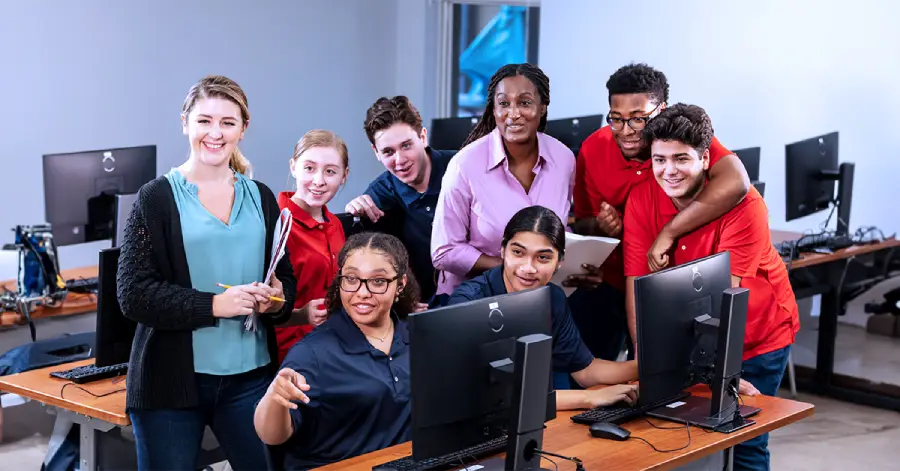Strategies for Enhancing Learning Platform Experience in EdTech
- Published on: June 17, 2024
- |
- Updated on: May 30, 2025
- |
- Reading Time: 6 mins
- |
-
Views
- |
Challenges in Enhancing Learning Platform Experience
Modernizing Platforms
Poor Market Exposure
Standards and Security Compliance
Lack of Visual Engagement
Slow Monetary Growth
How Can EdTech Companies Solve Challenges to Enhance Learning Platform Experience?
1. Enhancing Speed and User Experience with Scalable Technologies
2. Empowering Learning Through Feedback and Engagement
3. Rapid Framework Development
4. Accessibility and Localization
FAQs
In recent days, despite the potential, the EdTech industry has experienced numerous uncertainties that have hindered its progress. One of the significant issues is the incorporation of pointless technologies. As the saying goes, too much of anything is bad. This increases development costs and confuses the users, distracting them from the core educational process.
Another significant challenge that the EdTech industry faces is addressing learning loss recovery, which emerged as a critical issue globally due to widespread school closures and disruptions during the pandemic. According to the National Assessment of Educational Progress (NAEP), while the decline in test scores might seem abstract or theoretical, it actually has real-world economic consequences. This analysis also states that students on average are expected to earn 2-9% less over their lifetime. Hence, the EdTech industry needs to be agile and responsive to address the pressing issue of learning loss recovery effectively. This can be done by continuously monitoring student progress by leveraging innovative technologies like AI and immersive learning to provide personalized and adaptive learning experiences. EdTech companies can also bridge the learning gaps and support students in recovering from the learning losses they have experienced.
Moreover, EdTech companies face constant criticism for focusing too much on marketing and user acquisition over developing sustainable business models and high-quality products. This misguided focus has consequences, especially in times of economic uncertainty, contributing to the various struggles many EdTech companies face in providing quality learning platform experiences. However, apart from these hurdles, there are new challenges that EdTech companies need to address to enhance user experience.
Challenges in Enhancing Learning Platform Experience
Every obstacle – from technology limitations to user interface design presents unique challenges that must be addressed to provide the best possible outcomes on how to improve student learning management system experience.
Modernizing Platforms
One of the biggest challenges for EdTech companies is modernizing platforms to keep up with evolving user needs and technological advancements. Legacy products such as older versions of software or technology that have been used for years, often require significant updates to integrate new features, improve user interfaces, and ensure compatibility with modern devices and browsers. This process could be expensive and time-consuming, requiring significant investments in development, testing, and maintenance.
Additionally, legacy products at times have an existing user base that is accustomed to the old interface and functionality, making it crucial to strike a balance between the need for modernization and the need to maintain user satisfaction.
Poor Market Exposure
Trust is one of the most important factors in shaping the reputation of the EdTech industry. A significant challenge is the limited scope of digital marketing campaigns and insufficient outreach, particularly in semi-rural and semi-urban areas. This can hinder the growth of EdTech platforms and make it more challenging for them to connect with more people. Moreover, the lack of trust in digital payment methods may cause potential users to hesitate to opt for paid courses and services. This directly impacts their growth and profitability.
Standards and Security Compliance
Most EdTech companies lack the advanced technology and resources needed to effectively protect sensitive data and provide a personalized learning experience. This can be due to several reasons including reliance on third-party providers, lack of dedicated security professionals, and the huge data collection and storage. Complying with strict data privacy solutions such as FERPA and GDPR adds further complexity to the process as it requires EdTech providers to handle these data as per these laws. Moreover, many EdTech companies might not have the resources to invest in the latest security measures, making them more vulnerable to cyber threats like phishing attacks, ransomware, and social engineering.
Lack of Visual Engagement
Many EdTech solutions are not designed to handle multimedia content such as gamification and simulations, which are crucial for enhancing the learning platform experience. This is because these platforms often lack the technical capabilities to effectively integrate and manage multimedia content.
For example, SCORM (Sharable Content Object Reference Model) is a standard for packaging and delivering e-learning content. This can at times be complex to implement and manage for those without expertise in these technologies since its standards are highly based on XML and Java Script. This might lead EdTech companies to lag behind due to the lack of necessary expertise or resources to integrate multimedia content.
Slow Monetary Growth
Slow revenue growth is a common result of EdTech startups’ struggle to convert their large user bases into paying subscribers. This is partially because the industry prioritizes acquiring new users above creating long-term business models. Companies frequently prioritize expanding their market by providing additional discounts, and free courses which can result in a user base accustomed to free or heavily discounted services.
How Can EdTech Companies Solve Challenges to Enhance Learning Platform Experience?
1. Enhancing Speed and User Experience with Scalable Technologies
EdTech companies can leverage cloud-based infrastructure like AWS, and Microsoft Azure which allows them to quickly scale their infrastructure up or down based on consumer demand, ensuring they can handle increased user loads without over-exhausting resources. Additionally, implementing robust caching mechanisms and content delivery networks (CDNs) can drastically reduce page load times and enhance overall performance. EdTech companies can also enhance speed and user experience by leveraging cloud infrastructure that can provide students with offline access to learning resources, allowing them to learn even in areas with low internet connectivity.
2. Empowering Learning Through Feedback and Engagement
EdTech companies should prioritize transparent communication with various stakeholders regarding privacy practices, obtain informed consent before collecting and using any data, and educate staff members about data privacy best practices through comprehensive training and awareness programs. This can be done by implementing analytics without breaking any privacy or security laws and adhering to robust data security measures and privacy policies.
Another excellent way of empowering learning is by deriving insights. This can be achieved through different interactive models such as student-content interaction and student-instructor interaction that use statistical modeling and insight exploration tools to identify patterns in user behavior and tailor learning experiences accordingly.
3. Rapid Framework Development
Rapid framework development requires selecting a development partner to add and modify development features to the platform. This ensures that the learning platform is scalable, efficient, and socially and environmentally responsible. Hence, for EdTech companies, it becomes essential to prioritize partners with a proven track record of incorporating sustainable features such as energy-efficient data centers, renewable energy sources, and eco-friendly packaging. Additionally, these partners can also use AI to develop, test products, and integrate plug-and-play features like chatbots for personalized support, and adaptive learning pathways, ensuring a high-quality and engaging experience for students.
4. Accessibility and Localization
Since it’s impossible to predict individual accommodation, EdTech companies can accommodate assistive technologies and cater to varied learning styles. This includes incorporating features such as text-to-speech functionality, high contrast modes, screen readers, voice recognition software, and multiple language and regional settings. By embracing technology equity, EdTech companies can prioritize accessibility and localization by providing educational content in multiple languages and formats. Ensuring all the students, including those with disabilities have equal access to these resources.
While improving the learning platform experience involves addressing key challenges, it becomes crucial for EdTech companies to select the correct vendor. Choosing the right development partner with extensive experience in creating high-quality EdTech solutions and a proven track record of sustainable practices can help EdTech companies minimize their environmental impact and ensure that their solutions are socially responsible. Incorporating assistive technology and focusing more on feedback and engagement could create a more personalized and inclusive learning environment. If your focus is on how to improve the student learning experience, get in touch with Magic EdTech, for we provide comprehensive solutions for EdTech Development.
FAQs
Pointless technologies in EdTech might include flashy but non-essential features, gimmicky gadgets, or hardware products that deviate from the core mission of providing effective online learning experiences. For example, unnecessary virtual reality simulations or expensive hardware bundles that don't significantly improve learning outcomes.
Balancing the integration of new technologies without overwhelming users requires a user-centric approach. EdTech companies should focus on introducing technologies incrementally, ensuring that each new feature adds clear value and is user-friendly. Prioritizing user feedback during development phases and providing adequate training and support can help users adapt smoothly to new technologies.
EdTech companies should implement personalized learning plans that leverage data analytics to identify and address individual student needs. Utilizing adaptive learning technologies and offering supplementary tutoring sessions can provide targeted support. Collaborating with educational institutions to align recovery efforts with curricular goals can also enhance effectiveness.
Offer compelling value propositions such as exclusive content, personalized learning experiences, or premium features that enhance the learning experience. Implementing effective monetization strategies, such as tiered pricing plans or subscription bundles, can also help drive revenue growth.
Integrating multimedia content effectively involves investing in scalable infrastructure and development expertise. EdTech companies should utilize modern content management systems that support multimedia formats and adhere to standards like SCORM. Collaborating with experts in gamification and interactive media can enhance the quality of visual content. Ensuring that multimedia elements are mobile-friendly and accessible can also improve user engagement.

Get In Touch
Reach out to our team with your question and our representatives will get back to you within 24 working hours.


